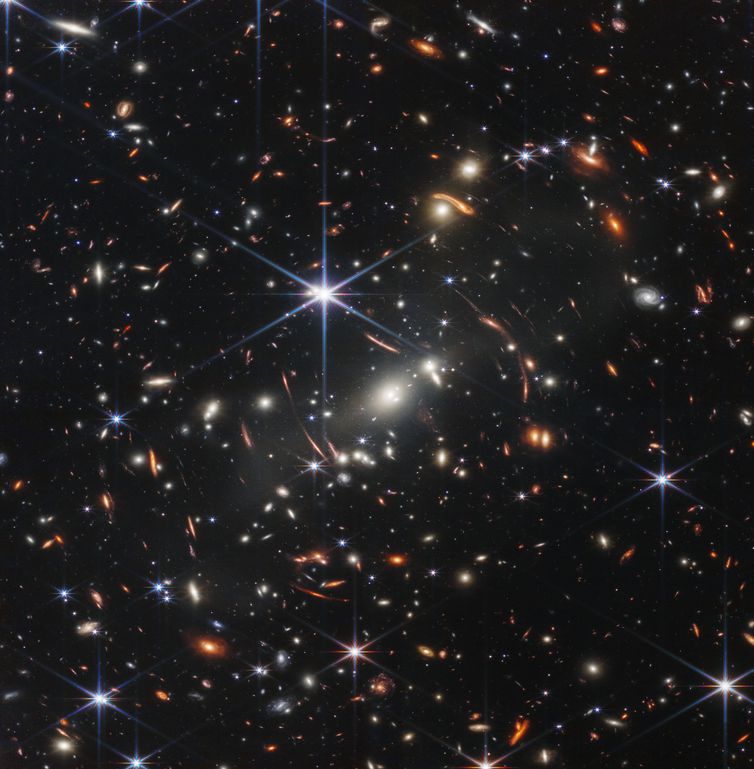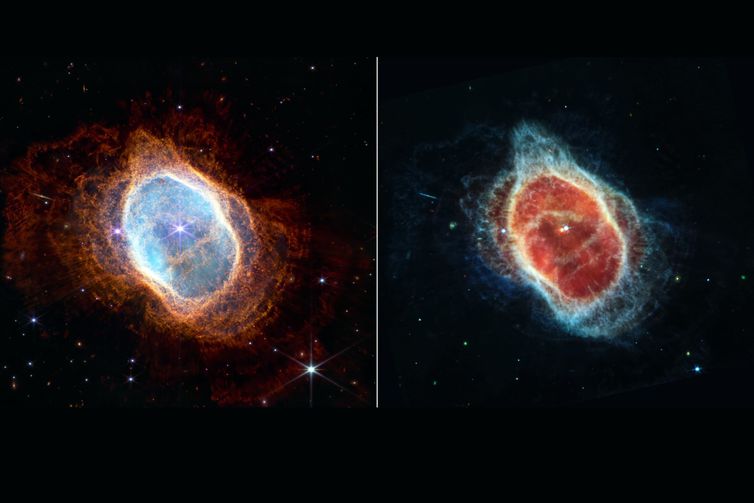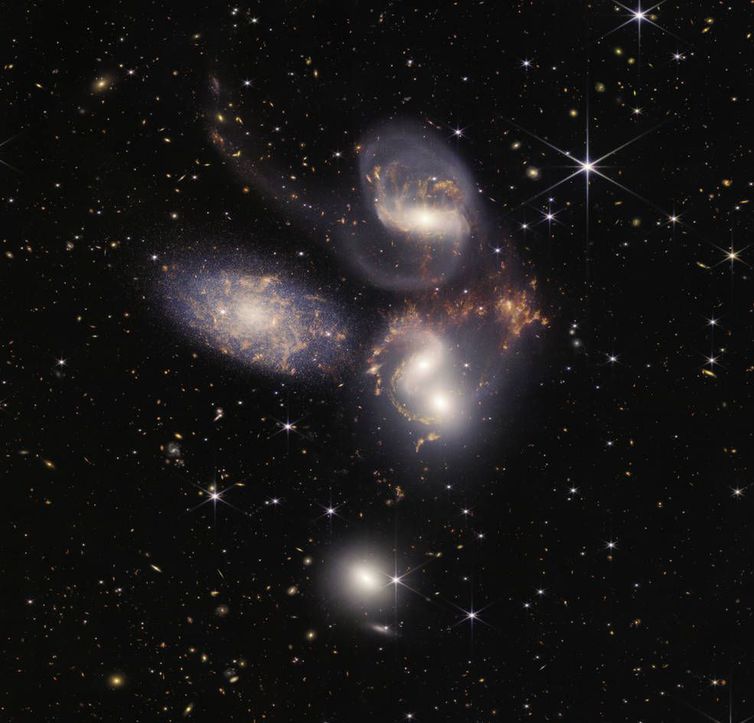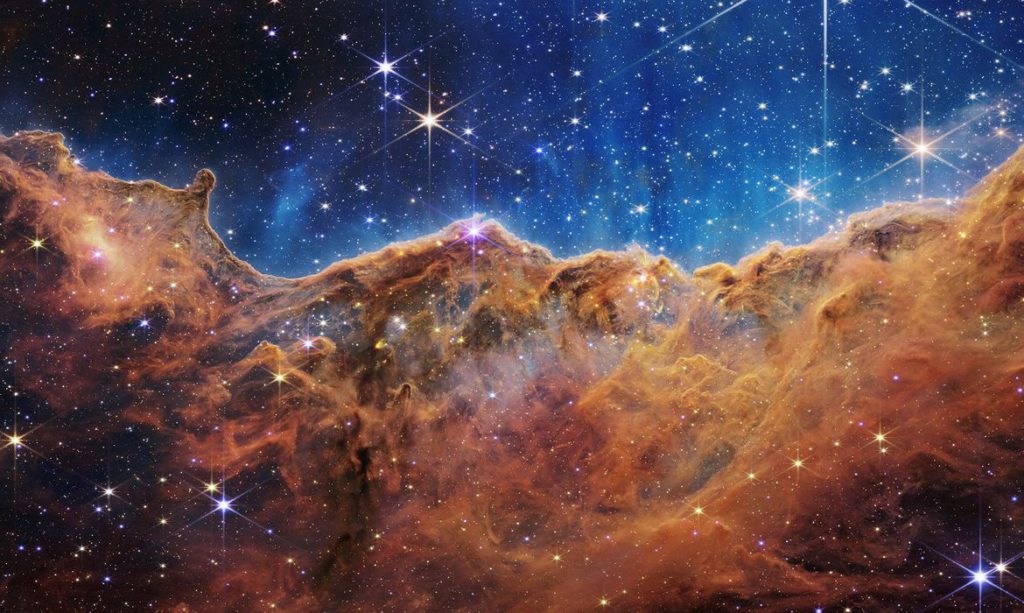Telescope could impact search for habitable planets
Four images and a spectrum released today (12) by the North American Space Agency (NASA) represent the first steps towards the great revolution foreseen for Astronomy. All images and data were recorded by the James Webb Space Telescope, launched in December 2021.
Since January 2022, this powerful equipment – the result of partnerships between the US, European and Canadian space agencies, whose main characteristic is the capture of infrared radiation – is located at the so-called L2 point, located at 1.5 million kilometers from Earth.
The first image, of the cluster of galaxies known as SMACS 0723, located 4.6 billion light years from Earth, was released yesterday (11) at an event at the White House that was attended by US President Joe Biden.
SMACS 0723
The deepest image of the Universe captured by James Webb shows a cluster of galaxies called SMACS 0723 that, combined, act as a gravitational lens.
The technique consists of observing the brightness amplification of a background star (called a source), due to the passage of an object (called a lens) between the observer and the source. The lens deforms the space-time around it and the light from the source is then deflected, thus generating an increase in its brightness for the observer.
According to NASA, this is the first opportunity to clearly observe galaxies and stars so distant and diffuse. “The light from these galaxies took billions of years to reach us. When we look at the youngest galaxies in this field, we are looking at less than a billion years after the Big Bang.

South ring nebula
The first unpublished images released today reveal details of the Southern Ring Nebula, which even showed a second star that forms a binary system (formed by two stars). Because they were in such close orbit, they looked like just a celestial body, which can only be unraveled thanks to infrared camera technology.
According to the researchers, it is an expanding cloud of gas, enveloping a dying star. It is nearly half a light-year in diameter and located approximately 2,500 light-years away from Earth.
A detail that caught the attention of scientists was the possibility of seeing galaxies even more distant, hidden by the nebula. During the live broadcast, made by NASA, the experts explained that nebulae have layers of gas and dust expelled by stars “as they die”.
The existence of binary systems was already known to scientists, but they have proved to be more and more common than previously thought. With James Webb, these systems will be more clearly observed.

WASP-96 exoplanet
NASA also presented a graph, called the spectrum, of the gas exoplanet WASP-96b, a giant about half the mass of Jupiter, located about 1,150 light-years from Earth. Spectrum is a technique that analyzes, through the color (temperature) of a celestial body, its physical and chemical composition. An exoplanet is a planet outside the Solar System.
Through the spectrum, James Webb was able to identify occurrences of oxygen and hydrogen, indicating the presence of water vapor at high temperature (above 500ºC), due to its proximity to the star, around which it orbits every 3.4 days.
The first detection of water on this exoplanet was made by the Hubble telescope in 2013. With the new telescope, it was possible to obtain, via the light spectrum, an “unmistakable signature of water” on this planet. “Webb’s powerful new observation also shows evidence of haze and clouds that previous studies of this planet had missed,” NASA reported.
With this, according to the agency, thanks to the signals detected, the expectation is that the James Webb will play an “important role in the search for potentially habitable planets in the coming years”, also estimating the presence of elements such as carbon, as well as the temperature. of the atmosphere.
Stephan’s Quintet
Located about 290 million light-years away from Earth in the constellation Pegasus, Stephan’s Quintet was also focused by the revolutionary telescope. According to the researchers, it is possible to observe the interaction of different galaxies in this group, with large tails of gas, dust and stars being extracted due to gravitational forces, as well as the process of creating some stars.
This proximity makes it possible for astronomers to observe the merger and interaction between galaxies, which are so crucial to the entire evolution of galaxies. “Scientists have rarely seen in such detail how interacting galaxies trigger star formation and how the gas in these galaxies is altered,” explains NASA. “Stephan’s quintet is a fantastic laboratory for studying these fundamental processes for all galaxies,” she added.
Webb also showed in detail, bright clusters of millions of young stars and regions where new stars are being born adorn the image. It is also possible to observe stars that are “hundreds of millions of times” more luminous than our system’s Sun.
Although it is not possible to visualize black holes present in these galaxies, it is possible to perceive their influence on other celestial bodies. According to the US agency, the image shows, in this quintet, “streams driven by black holes in a level of detail never seen before”.

Carina Nebula
Another revolutionary image released today by NASA resembles a “cosmic cliff”, in the words of the agency itself (featured image at the top of the article). This is the Carina Nebula, with its “stellar nurseries and nascent stars” that could not be perceived by previous images recorded by the Hubble telescope.
“This landscape of ‘mountains’ and ‘valleys’ dotted with bright stars is actually the edge of a young star-forming region. It’s actually the edge of the gas giant cavity. The highest peaks are about 58 light-years [high]. The cavernous zone was sculpted into the nebula by intense ultraviolet radiation and stellar winds from extremely large and hot young stars.”
By observing this region, it will be possible to understand more about the process of star formation. “Star birth propagates over time, triggered by the expansion of the eroded cavity. As the bright, ionized edge moves towards the nebula, it is slowly pushed into gas and dust. If the edge encounters any unstable material, the increasing pressure will cause the material to collapse and form new stars.”
“On the other hand, this type of disturbance can also prevent the formation of stars, as the material that forms them is eroded. This is a very delicate balance between causing star formation and stopping it.”
In this way, James Webb will help scientists advance studies that address “some of the great unknowns of modern astrophysics.” Among them, about what determines the number of stars that form in a given region; and what causes stars to form with their respective masses.
Something amazing to be discovered
At the end of the event to disclose the images, the administrator of NASA, Bill Nelson, quoted a speech by astronomer Carl Sagan to describe the expectations that the researchers involved with James Webb go through: “Somewhere, something incredible is to be discovered. ”.
“We are now able to answer things we didn’t even know how to ask. Progress like this is inspiring, and inspiration is the fuel that moves NASA. And it is the food of humanity. Let’s now open the envelope. We have to risk it because the reward is greater than the risk. That’s exactly what these images show,” he said.



